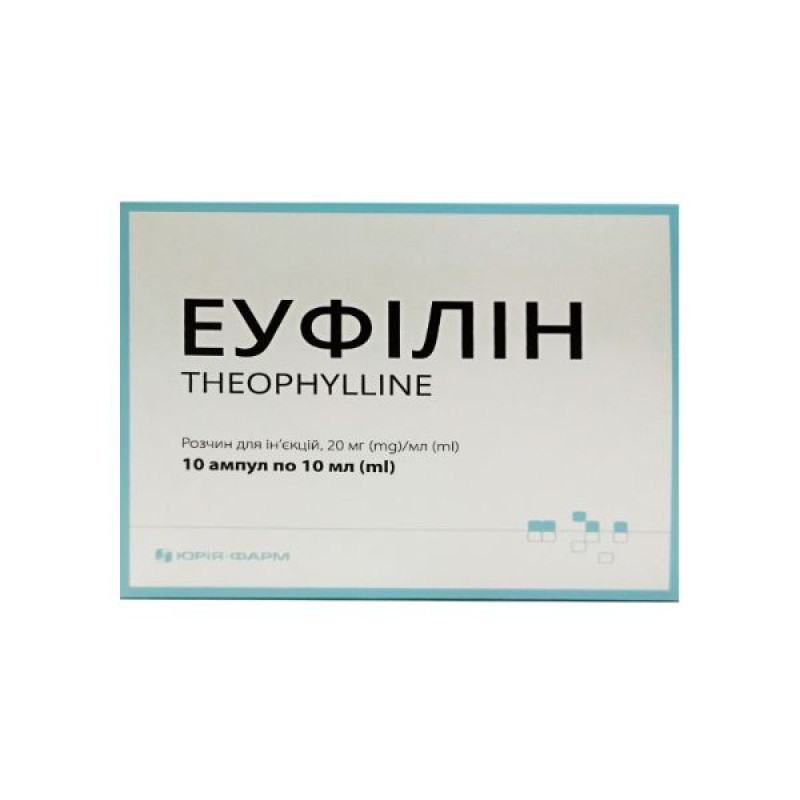Euphyllin solution for injection 2% ampoule 10ml No. 10

Euphyllin is a drug for systemic use in obstructive airway diseases. Xanthines.
Indications for use - broncho-obstructive syndrome in bronchial asthma, bronchitis, pulmonary emphysema, disorders of the respiratory center (paroxysmal nocturnal apnea), "pulmonary heart".
Warehouse
1 ml of solution contains theophylline monohydrate equivalent to theophylline 20 mg; excipients: sodium acetate trihydrate, water for injection.Contraindication
Hypersensitivity to the components of the drug, to other xanthine derivatives (caffeine, pentoxifylline, theobromine); acute heart failure, angina pectoris, acute myocardial infarction, decompensated chronic heart failure, paroxysmal tachycardia, extrasystole, severe arterial hyper- and hypotension, widespread atherosclerosis of vessels, pulmonary edema, hemorrhagic stroke, retinal hemorrhage, history of bleeding, gastric and duodenal ulcer in the acute stage, gastroesophageal reflux, epilepsy, glaucoma, increased convulsive readiness, uncontrolled hypothyroidism, hyperthyroidism, thyrotoxicosis, severe hepatic and/or renal failure, porphyria, sepsis, use in children simultaneously with ephedrine.
Method of application
Administer intravenously by slow jet (for at least 5 minutes), intravenously by drip – at a rate of 30–50 drops/minute.
When administering the drug, calculate the dose in milligrams of theophylline, considering that 1 ml of the drug contains 20 mg of theophylline.
Adults should be administered intravenously by jet injection at a daily dose of 10 mg/kg of body weight (on average 600–800 mg), divided into 3 injections. In case of cachexia and for people with an initial low body weight, the daily dose should be reduced to 400–500 mg, while during the first injection no more than 200–250 mg should be administered. If palpitations, dizziness or nausea occur, the rate of administration should be reduced or switched to intravenous drip administration.
Children over 14 years of age: intravenously drip at a dose of 2–3 mg/kg of body weight. The maximum daily dose for children over 14 years of age is 3 mg/kg of body weight.
Application features
Before administration, the solution must be warmed to body temperature.
Use with caution in diseases of the cardiovascular system, liver, viral infection, prolonged hyperthermia, prostatic hypertrophy, severe hypoxia, diabetes mellitus, glaucoma, elderly patients (over 60 years). Use with caution only in cases of acute need, in cases of impaired renal function, as well as in patients with a history of gastric and duodenal ulcers. If the patient has a history of convulsions, theophylline should be avoided and alternative treatment should be used. The drug should be used with caution in patients suffering from insomnia.
Pregnant women
The drug is contraindicated during pregnancy.
Children
The drug should not be used for intravenous administration in children under 3 years of age.
Drivers
Considering that sensitive patients may experience adverse reactions (dizziness, others) when using the drug, during the treatment period it is necessary to refrain from potentially dangerous activities that require increased attention and speed of psychomotor reactions.
Overdose
With rapid intravenous administration, convulsions, arrhythmias, severe hypotension, angina pectoris are possible. At plasma theophylline concentrations above 20 mg/ml (110 μmol/l), nausea, vomiting (repeated vomiting, sometimes with blood, can lead to dehydration), diarrhea, agitation, tremor, arterial hypertension, hyperventilation, supraventricular and ventricular arrhythmias, arterial hypotension, coma, convulsions, metabolic disorders (hypokalemia, hypercalcemia, hypophosphatemia, hyperuricemia, hyperglycemia, metabolic acidosis, respiratory alkalosis) are observed.
Side effects
From the side of the central and peripheral nervous system: agitation, anxiety, restlessness, anxiety, sleep disturbances, insomnia (especially in children), headache, dizziness, tremor, irritability, seizures, hallucinations, delirium, epileptiform seizures, confusion/loss of consciousness, presyncopal state.
From the cardiovascular system: palpitations, cardialgia, arrhythmias, tachycardia, extrasystole (ventricular, supraventricular), decreased blood pressure, heart failure, increased frequency of angina attacks, collapse (with rapid intravenous administration), shock.
On the part of the urinary system: increased diuresis (due to increased glomerular filtration), in elderly patients - difficulty urinating (due to relaxation of the detrusor).
Storage conditions
Store at a temperature not exceeding 30C. Do not freeze. Keep out of the reach of children.
There are no reviews for this product.
There are no reviews for this product, be the first to leave your review.
No questions about this product, be the first and ask your question.



